
GOAL APPROACH
RESOURCE – BASED APPROACH
Internal process approach
Balanced scorecard
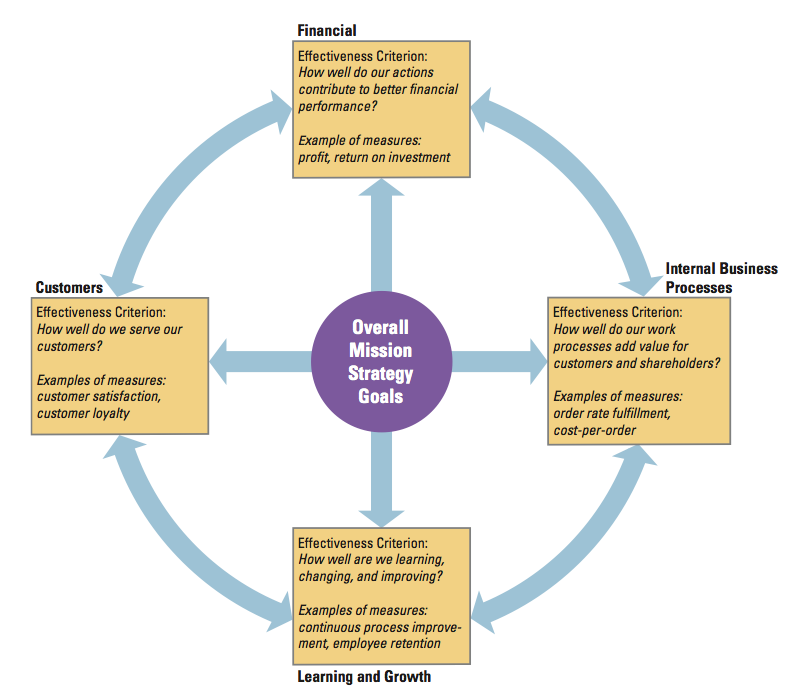
Topic 3 ORG STRUCTURES
Self-study, reference materials in the textbook
Information-Sharing Perspective on Structure: Vertical Information Sharing • Horizontal Information Sharing
Functional, Divisional, and Geographic Designs
Matrix Structure
Horizontal Structure
Virtual Networks and Outsourcing
Hybrid Structure
Basing on the practical task of changing the type of the structure:
Be able to give examples of material and non-material effects of restructuring, examples of improved behavior.
Topic 4 EXTERNAL ENVIRONMENT
Organizational environment is defined as all elements that exist outside the boundary of the organization and have the potential to affect all or part of the organization;
Domain defines the organization’s niche and defines those external sectors with which the organization will interact to accomplish its goals;
Ten sectors can be analyzed for each organization: industry, raw materials, human resources, financial resources, market, technology, economic conditions, government, sociocultural, and international
Task environment includes sectors with which the organization interacts directly and that have a direct impact on the organization’s ability to achieve its goals. The task environment typically includes the industry, raw materials, and market sectors, and perhaps the human resources and international sectors.
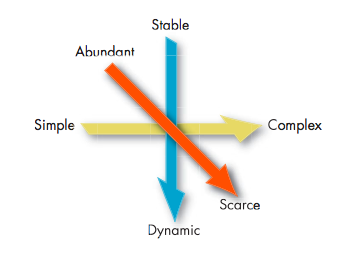
A complex environment is one in which the organization interacts with and is influenced by numerous diverse external elements. (aerospace)
In a simple environment, the organization interacts with and is influenced by only a few similar external elements
(family-owned stores)
An environmental domain is stable if it remains the same over a period of months or years. (Public utility)
Under unstable conditions, environmental elements shift abruptly. Environmental domains seem to be increasingly unstable for most organizations. (Toy companies)

|
|
LOW UNCERTAINTY |
LOW-MODERATE |
|
STABLE |
Mechanistic structure: formal, centralized Few departments No integrating roles Current operations orientation; low-speed response |
Mechanistic structure: formal, centralized Many departments, some boundary spanning Few integrating roles Some planning; moderate-speed response |
|
|
HIGH-MODERATE UNCERTAINTY |
HIGH UNCERTAINTY |
|
UNSTABLE |
Organic structure, teamwork: participative, decentralized Few departments, much boundary spanning Few integrating roles Planning orientation; fast response |
Organic structure, teamwork: participative, decentralized Many departments differentiated, extensive boundary spanning Many integrating roles Extensive planning, forecasting; high-speed response |
|
ENVIRONMENT COMPLEXITY |
SIMPLE |
COMPLEX |
Topic 5 ORG DESIGN AND INTERNAL PROCESSES
Differentiation refers to “the differences in cognitive and emotional orientations among managers in different functional departments, and the difference in formal structure among these departments.”
Integration is the quality of collaboration among departments.
ORGANIZATIONAL DESIGN Refer to Mechanistic and Organic management models
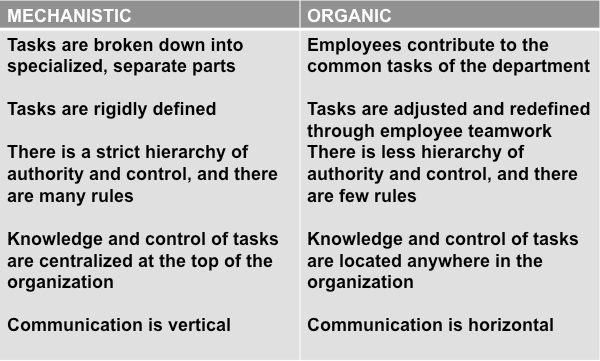
How environment influences internal processes
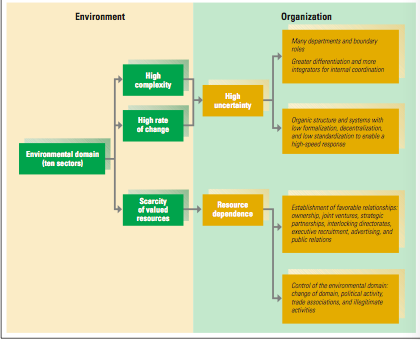
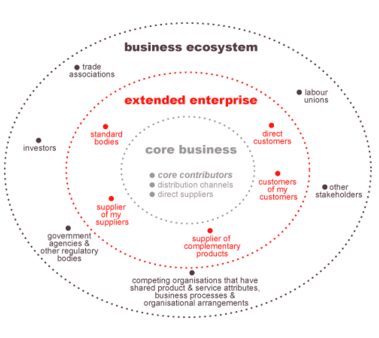
Outdated system of management/ opposite will be modern one
Enforce order and uniformity
Vertical structuring and reporting
Top down initiatives
Competitive relationships
Forcing relationships with suppliers
Handling operational roles
Direct control over people and resources
Rigidness and reactive approach
Defending organization’s boundaries and maintaining direct control
TOPIC 6. ORGANIZATIONAL DYNAMICS

Large size is crucial to economic health in some industries. Size enables economies of scale, provides a wide variety of opportunities for employees, and allows companies to invest in expensive and risky projects.
Large organizations have a hard time adapting to rapid changes in the environment. Large organizations are typically standardized, mechanistically run, and complex.
Small organizations typically have a flatter structure and an organic, free-flowing management. They can respond more quickly to environmental changes and are more suited to encouraging innovation and entrepreneurship.
Managers in large or growing firms try to find mechanisms to make their organizations more flexible and responsive.
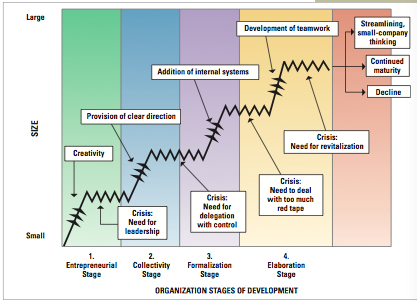
Organizational characteristics during the life cycle

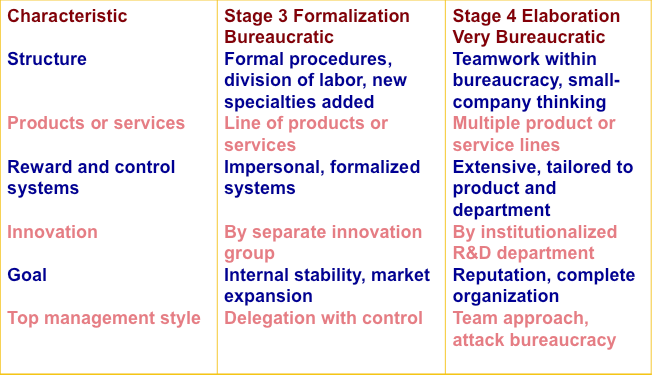
BUREAUCRACY
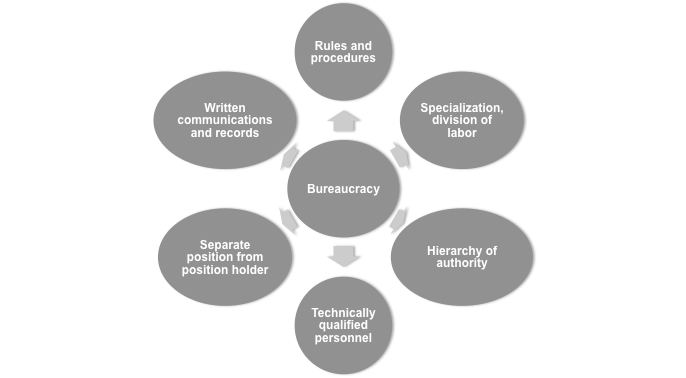
Formalizationrefers to rules, procedures, and written documentation, such as policy manuals and job descriptions, that prescribe the rights and duties of employees.Centralization refers to the level of hierarchy with authority to make decisions. In centralized organizations, decisions tend to be made at the top. In decentralized organizations, similar decisions would be made at a lower levelpersonnel ratiosfor administrative, clerical, and professional support staff. The most frequently studied ratio is the administrative ratio.
BUREAUCRACY VERSUS OTHER FORMS OF CONTROL
Even though many organizations are trying to reduce bureaucracy and streamline rules and procedures that constrain employees, every organization needs systems for guiding and controlling the organization. Employees may have more freedom in today’s companies, but control is still a major responsibility of management.
Managers at the top and middle levels of an organization can choose among three overall control strategies. These strategies come from a framework for organizational control proposed by William Ouchi of the University of California at Los Angeles. Ouchi suggested three control strategies that organizations could adopt—bureaucratic, market, and clan.Each form of control uses different types of information. However, all three types may appear simultaneously in an organization.
Bureaucratic Control
Bureaucratic control is the use of rules, policies, hierarchy of authority, written doc- umentation, standardization, and other bureaucratic mechanisms to standardize behavior and assess performance. Bureaucratic control uses the bureaucratic characteristics defined by Weber and illustrated in the picture above. The primary purpose of bureaucratic rules and procedures is to standardize and control employee behavior.
Recall that as organizations progress through the life cycle and grow larger, they become more formalized and standardized. Within a large organization, thousands of work behaviors and information exchanges take place both vertically and horizontally. Rules and policies evolve through a process of trial and error to regulate these behaviors. Some degree of bureaucratic control is used in virtually every organization. Rules, regulations, and directives contain information about a range of behaviors.
To make bureaucratic control work, managers must have the authority to maintain control over the organization. Weber argued that legitimate, rational authority granted to managers was preferred over other types of control (e.g., favoritism or payoffs) as the basis for organizational decisions and activities. Within the larger society, however, Weber identified three types of authority that could explain the creation and control of a large organization.
Rational-legal authority is based on employees’ belief in the legality of rules and the right of those elevated to positions of authority to issue commands. Rational- legal authority is the basis for both creation and control of most government organizations and is the most common base of control in organizations worldwide.
Traditional authority is the belief in traditions and in the legitimacy of the status of people exercising authority through those traditions. Traditional authority is the basis for control for monarchies, churches, and some organizations in Latin America and the Persian Gulf.
Charismatic authority is based on devotion to the exemplary character or to the heroism of an individual person and the order defined by him or her. Revolutionary military organizations are often based on the leader’s charisma, as are North American organizations led by charismatic individuals such as Steve Jobs of Apple, Tom Anderson of MySpace, or Oprah Winfrey of Harpo Productions. The organization reflects the personality and values of the leader.
More than one type of authority—such as long tradition and the leader’s special charisma—may exist in organizations, but rational-legal authority is the most widely used form to govern internal work activities and decision making, particularly in large organizations.
Market Control
Market control occurs when price competition is used to evaluate the output and productivity of an organization or its major departments and divisions. The idea of market control originated in economics.A price is an efficient form of control, because managers can compare prices and profits to evaluate the efficiency of their corporation. Top managers nearly always use the price mechanism to evaluate performance in their corporations. Corporate sales and costs are summarized in a profit-and-loss statement that can be compared against performance in previous years or with that of other corporations.
The use of market control requires that outputs be sufficiently explicit for a price to be assigned and that competition exist. Without competition, the price does not accurately reflect internal efficiency. Even some government and traditionally nonprofit organizations are turning to market control.
Market control was once used primarily at the level of the entire organization, but it is increasingly used in product divisions or individual departments. Profit centers are self-contained product. Each division contains resource inputs needed to produce a product. Each division can be evaluated on the basis of profit or loss compared with other divisions.The network organization illustrates market control as well. Different companies compete on price to provide the functions and services required by the hub organization. The organization typically contracts with the company that offers the best price and value.
Traditional control mechanisms based on strict rules and close supervision are ineffective for controlling behavior in conditions of high uncertainty and rapid change.In addition, the growing use of communication and interactive technologies, which often leads to a democratic spread of information throughout the organization, is influencing companies to depend less on bureaucratic control and more on shared values that guide individual actions for the corporate good.
Clan control is most often used in small, informal organizations where people are strongly committed to the organization’s purpose, or in certain departments or divisions of larger organizations.
Clan Control
Clan control is the use of social characteristics, such as shared values, commitment, traditions, and beliefs, to control behavior. Organizations that use clan control have strong cultures that emphasize shared values and trust among employees.Clan control is important when ambiguity and uncertainty are high. High uncertainty means the organization cannot put a price on its services, and things change so fast that rules and regulations are not able to specify every correct behavior. Under clan control, people may be hired because they are committed to the organization’s purpose, such as in a religious organization or an organization focused on a social mission. New employees are typically subjected to a long period of socialization to gain acceptance by colleagues. There is strong pressure to conform to group norms, which govern a wide range of employee behaviors. Managers act primarily as mentors, role models, and agents for transmitting values.
Today’s companies that are trying to become learning organizations often use clan control or self-control rather than relying on rules and regulations. Self-control is similar to clan control, but whereas clan control is a function of being socialized into a group, self-control stems from individual values, goals, and standards. The organization attempts to induce a change such that individual employees’ own internal values and work preferences are brought in line with the organization’s values and goals. With self-control, employees generally set their own goals and monitor their own performance, yet companies relying on self-control need strong leaders who can clarify boundaries within which people exercise their own knowledge and discretion.
Clan control or self-control may also be used in some departments, such as strategic planning, where uncertainty is high and performance is difficult to measure. Managers of departments that rely on these informal control mechanisms must not assume that the absence of written, bureaucratic control means no control is present. Clan control is invisible yet very powerful. One study found that the actions of employees were controlled even more powerfully and completely with clan control than with a bureaucratic hierarchy.73 When clan control works, bureaucratic control is not needed.
|
Type |
Requirements |
|
Bureaucracy |
Rules, standards, hierarchy, legitimate authority |
|
Market |
Prices, competition, exchange relationship |
|
Clan |
Tradition, shared values and beliefs, trust |
Organizational decline stage:
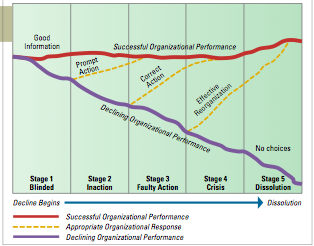
Organizational decline-a condition in which a substantial, absolute decrease in an organization’s resource base occurs over time
Three factors that cause Organizational decline:
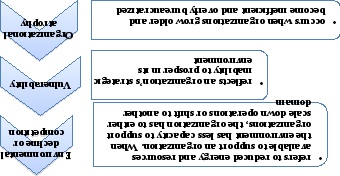
DISCUSSION QUESTIONS:
Why do large organizations tend to have larger ratios of clerical and administrative support staff? Why are they typically more formalized than small organizations?
Why do you think organizations feel pressure to grow?
Look through several recent issues of a business magazine such as Fortune, BusinessWeek, or Fast Company and find examples of two companies that are using approaches to busting bureaucracy. Discuss the techniques these companies are applying.
Government organizations often seem more bureaucratic than for-profit organizations. Could this partly be the result of the type of control used in government organizations? Explain.
Numerous large financial institutions, including Lehman Brothers and Merrill Lynch, experienced significant decline or dissolution in recent years. Which of the three causes of organizational decline seems to apply most clearly to these firms?
Do you think a “no growth” philosophy of management should be taught in business schools? Discuss.
Week 17 Revision, terms and final test
COMPANY ANALYSIS #5
THE ANALYSIS OF COMPANY LIFY CYCLE (ORGANIZATION STAGES OF DEVELOPMENT)
A) As organizations evolve through the four stages of the life cycle, changes take place in structure, control systems, innovation, and goals. Identify 4 stages for the company that you analyze. Provide timing, specific features, refer the features to the characteristics from the table (Organizational characteristics during the life cycle) describe what actions have been taken for further development.
B) Most companies experience significant decline or dissolution. Identify one example of this trend in the company that you analyze. Which of the three causes of organizational decline described above seems to apply most clearly to your example? Explain why. What has been done by the management of the company to avoid final, “no choice” stage?
TERMS for the final test.
|
Globalization Ethical scrutiny Diversity
Organization Value creation External environment Transaction costs Division of labor
Formalization Specialization Hierarchy of authority Centralization Professionalism Personnel ratios Organizational technology The organization’s goals and strategy Organizational culture Organizational structure Organizational design Organizational change
Efficiency Effectiveness Stakeholder approach A stakeholder
The mechanistic model The organic model
Organizational goal Strategic intent The mission Competitive advantage Company’s core competence
|
Operative goals Goal approach Resource – based approach Internal process approach Balanced scorecard Vertical Information Sharing Horizontal Information Sharing Functional Design Divisional Design Geographic Design
Matrix Structure Horizontal Structure Hybrid Structure
Organizational Environment Domain Task environment Environment uncertainty Environment complexity Differentiation Integration Business ecosystem Extended enterprise Core business
Entrepreneurial stage Collectivity stage Formalization stage Elaboration stage Bureaucracy
Formalization Centralization Bureaucratic control Rational-legal authority Traditional authority Charismatic authority Market control Clan control
Organizational decline Organizational atrophy Organizational vulnerability
|
TEMPLATE
ORGANIZATIONAL THEORY 2015-2016.
